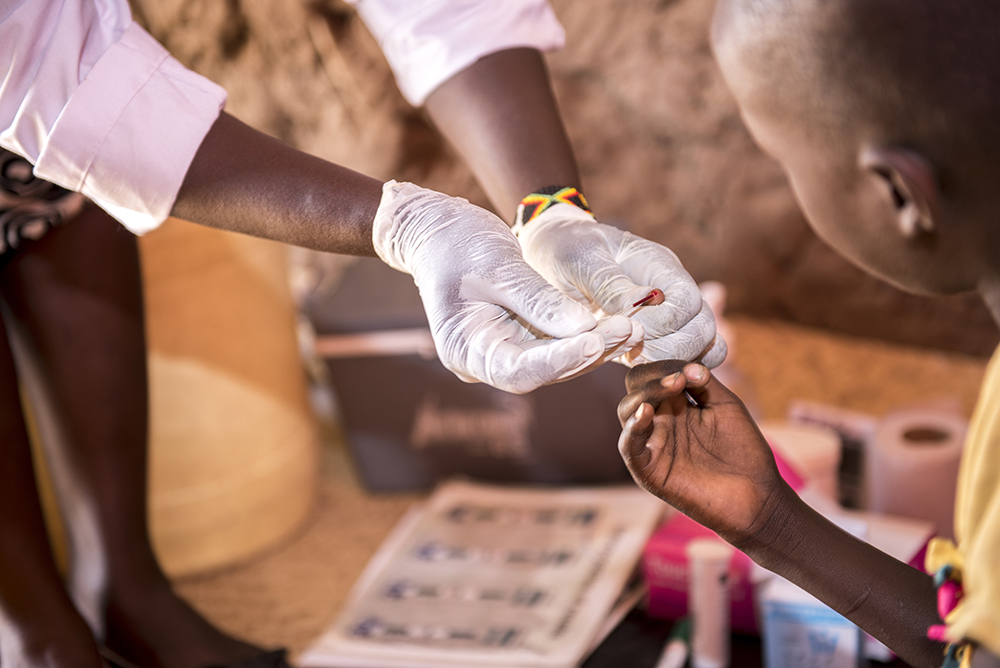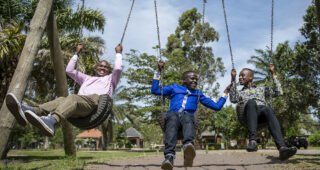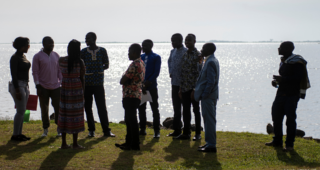Testing in a Manyatta
It’s 107 degrees Fahrenheit at midday in a village outside of Lodwar, Kenya. Goats and children dash across the sand, while most adults have retreated to the sensible shade of their manyattas, traditional family homes built of sticks, thatch, and mud.
Two women in long white coats, Esther Kapoko and Anna Akeru, stride through the village. Following a map drawn for them three days earlier, Esther and Anna stop at the manyatta of Joyce Ewoton, who greets them at the entrance along with three of her children, Evaline, 16; Bartholomew, 8; and Benjamin, 5.

Esther is an HIV testing counselor and Anna is a linkage officer, colleagues at the Lodwar County Referral Hospital, where Joyce receives HIV care and treatment. A widow living with HIV, Joyce is an “index client,” meaning that her household has been targeted for testing and counseling to ensure that any other family member living with HIV is identified and linked to treatment.
Joyce learned her own HIV-positive status two years ago when her husband died of an AIDS-related illness.
During Joyce’s recent visit to the hospital to pick up her antiretroviral medicine, Esther and Anna made an appointment to come test the children. Joyce immediately agreed to the visit. The hospital is 10 kilometers away and the family doesn’t own a vehicle or donkey.

Communities in Turkana, this arid northern county, face many public health challenges as a result of food scarcity, distance from health facilities, and the nomadic culture. Through the Pamoja (which means “together” in Swahili) project, the Elizabeth Glaser Pediatric AIDS Foundation (EGPAF) has focused on overcoming these challenges by adding HIV services to local health centers, training peer counselors within communities, and initiating community-based testing and counseling by health workers like Esther and Anna.
With Bartholomew and Benjamin looking on eagerly, Esther and Anna enter the manyatta. Esther retrieves a square of black plastic from her kit and spreads it on the tamped sand floor. She then places her rapid testing apparatus on the plastic along with a spiral pictograph book that explains the process, step-by-step. In the Turkana language, Esther explains that she will be pricking the finger of each child to take a blood sample. Then she will apply the blood to a tester. If the tester shows two lines, it will indicate that the child is positive for HIV and Anna will then link the child to the hospital for a confirmation test and likely treatment.
One by one, the children come forward and face the sharp prick. Benjamin’s eyes well with tears in surprise, but his older brother and sister put on tough faces.


While they wait for the tests, Esther gives a short HIV lesson, explaining how it can be transmitted as well as the effectiveness of sustained treatment.
Within the Turkana context, children run an additional risk of infection as they are growing up because it is traditional to shave their heads with a straight razor blade, usually using the same blade for many people. Esther cautions against this practice. Privately, she talks to Evaline about the importance of abstinence or using condoms now that she is reaching the age of sexual maturity.
With ten minutes passed, Esther reviews the test results with Joyce and her children. Joyce gives a relieved laugh when she sees that all of the children are HIV-free.
“I was not worried,” Joyce says, “but I am happy to see the results. I feel good.”
Esther and Anna pack up their kit, chatting with Joyce and her children about their general well-being. With some final hugs, the two health workers bid farewell. Outside the village, they hope to find a motorbike taxi to transport them back to the hospital.
“Joyce is an exemplary client,” says Esther. “When we came here, we asked her if she worried about stigma of living with HIV. She told us that she accepts her status. She wants other people to learn the way she is behaving, so she doesn’t mind neighbors seeing that the children are getting tested at home.”

This mission is personal for Esther. Her sister and brother-in-law died from AIDS-related illness several years ago and she is now raising their three children along with three of her own. Her sister’s youngest daughter is living with HIV, and Esther is the one who tested her and linked her to HIV care and treatment.
Working with their colleagues at the hospital, with technical assistance from EGPAF, Esther and Anna regularly participate in data reviews to track their progress in reaching family members affected by HIV to make sure that they are tested for HIV and are linked to treatment. They say that they are on track to surpass their goal of testing 90 percent of the family members of their index clients this year.
The Value of Testing Early
Testing all children affected by HIV is the first step in ending AIDS in children. At EGPAF-supported sites, pregnant women are routinely tested for HIV so that they can be enrolled in prevention of mother-to-child transmission (PMTCT) of HIV. Their infants are tested for HIV throughout the postnatal and breastfeeding periods to ensure that they are HIV-free. If a mother with children tests positive for HIV, her children are identified for testing so that they can be put on treatment if they are HIV-positive.
The average age of treatment initiation for children living with HIV is 4-and-a-half. Yet we know that without treatment most HIV-infected children will die before the age of 5. This means that many undiagnosed children are dying. Changing this requires an approach that is both urgent and pragmatic. Traditional health sites and clinics are not reaching enough children, so EGPAF is working to reach them where they live, learn, and play.
Eric Bond, EGPAF
Kenya
Adolescent Identification, Care & Treatment



